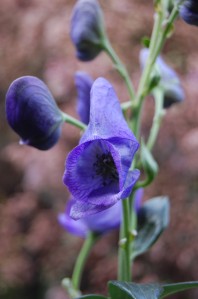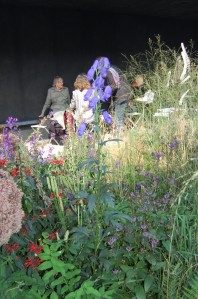Position: Full sun to partial shade
Flowering period: Late summer
Soil: Well drained soils
Eventual Height: 1.6m
Eventual Spread: 40cm
Hardiness: 3a, 3b, 4a, 4b, 5a, 5b, 6a, 6b, 7a, 7b, 8a, 8b, 9a
Family: Ranunculaceae
Aconitum carmichaelii is deciduous herbaceous perennial with a clump forming upright habit. Its dark green leaves are palmate or deeply palmatley lobed with 5-7 segments, each one with coarse sharp teeth. They have a spiral or alternate arrangement with the lower leaves bearing long petioles. Its blue flowers are hooded, have numerous stamens and are zygomorphic. Its fruit is a dry follicle. Its roots are tuberous which aids its spread.
The species Aconitum carmichaelii, commonly known as Chinese Aconite, Carmichael’s Monkshood or Chinese Wolfsbane, is native to East Asia. All parts of this plant are extremely toxic.
The etymological root of the binomial name Aconitum is from the ancient Greek name for this plant and is loosely translated as ‘unconquerable poison’. Carmichaelii is named after the plant hunter Captain Dugald Carmichael (1772–1827).
The landscape architect may find Aconitum carmichaelii wilsonii group ‘Barkers’ useful in shady moist locations. It will provide vertical accents in herbaceous planting schemes. Care should be taken when locating this plant due to its poisonous nature (toxic if eaten and harmful via skin).
Ecologically, Aconitum carmichaelii wilsonii group ‘Barkers’ is attractive to bees and butterflies. It is also used as a food plant by some Lepidoptera species including the Dot Moth, Mouse Moth, Engrailed Moth and Yellow tail.
Aconitum carmichaelii wilsonii group ‘Barkers’ prefers well drained, fertile moderately moist soils in the PH range of 6.6 to 7.5. It can tolerate both shady and sunny spots but grows notably well in shady areas beneath tree canopies.
Aconitum carmichaelii wilsonii group ‘Barkers’ requires little to no maintenance. The dead flowering spikes may be removed in early spring. When clumps become large they may be divided in late autumn.







Leave a comment